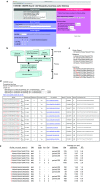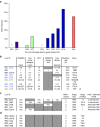COSMID: A Web-based Tool for Identifying and Validating CRISPR/Cas Off-target Sites
- PMID: 25462530
- PMCID: PMC4272406
- DOI: 10.1038/mtna.2014.64
COSMID: A Web-based Tool for Identifying and Validating CRISPR/Cas Off-target Sites
Abstract
Precise genome editing using engineered nucleases can significantly facilitate biological studies and disease treatment. In particular, clustered regularly interspaced short palindromic repeats (CRISPR) with CRISPR-associated (Cas) proteins are a potentially powerful tool for modifying a genome by targeted cleavage of DNA sequences complementary to designed guide strand RNAs. Although CRISPR/Cas systems can have on-target cleavage rates close to the transfection rates, they may also have relatively high off-target cleavage at similar genomic sites that contain one or more base pair mismatches, and insertions or deletions relative to the guide strand. We have developed a bioinformatics-based tool, COSMID (CRISPR Off-target Sites with Mismatches, Insertions, and Deletions) that searches genomes for potential off-target sites (http://crispr.bme.gatech.edu). Based on the user-supplied guide strand and input parameters, COSMID identifies potential off-target sites with the specified number of mismatched bases and insertions or deletions when compared with the guide strand. For each site, amplification primers optimal for the chosen application are also given as output. This ranked-list of potential off-target sites assists the choice and evaluation of intended target sites, thus helping the design of CRISPR/Cas systems with minimal off-target effects, as well as the identification and quantification of CRISPR/Cas induced off-target cleavage in cells.
Figures


References
Grants and funding
LinkOut - more resources
Full Text Sources
Other Literature Sources

